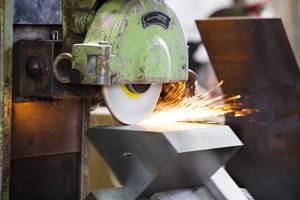Why Your Shop Needs an IIoT Roadmap
An IIoT roadmap defines a specific path for reaching data-driven manufacturing. This roadmap shows where a manufacturing company is starting out, and then defines how to proceed along a continuous series of implementations.
In a recent conversation with Ramshankar Coimbatore Somasundaram (Ram C.S.) the CEO of Maxbyte Technologies, an IIoT solutions supplier based in India, the need for an IIoT roadmap came up. We discussed the value of this roadmap and agreed that it was a useful concept for manufacturers to consider right now. The concept clarified critical aspects of the current situation for manufacturing companies and suggested how they might move forward. In short, companies ought to have an IIoT roadmap.
Initially, the discussion assumed answers to two basic questions. First, what is a roadmap? A roadmap helps you get from a starting point to a destination by defining a specific path. It shows what roads or highways to take. It may also give a list of travel steps such as exit numbers or distances between points.
Second, what is IIoT? It is the Industrial Internet of Things, and by its nature, it is the reason a shop needs a “roadmap.” IIoT is a term used to describe the emerging technology that enables data to be collected from industrial equipment and shared across a network, specifically one using the Internet as the universal connection. The IIoT is envisioned as the means by which most, if not all, decisions about industrial processes are more effective because they are based on data. However, the concept behind the IIoT (and the related term Industry 4.0) is so broad and all-encompassing that it is difficult to imagine how a company can enter this territory without the risk of losing its way and not being able to reach an environment enriched by greater efficiency and higher profits.
Mr. C.S. said that an IIoT roadmap is, by analogy, a specific path for reaching data-driven manufacturing. This roadmap shows where a manufacturing company is starting out, and then defines how to proceed along a continuous series of implementations. For example, a shop may start by installing a machine data-collection system to monitor machine and operator performance and relate them to productivity. “The roadmap, however, shows that this is just the first leg of the journey. Having and following a roadmap keeps a company from turning down a dead-end street or having to backtrack to reach a connection that leads to the next level of improved decision-making,” he said. He emphasized that the roadmap gives the shop direction as well as promotes forward motion, adding that the roadmap should clearly state the business case for the transition to data-driven manufacturing. “If you talk IIoT, you must also talk ROI (return on investment),” he said.
Mr. C.S. went on to explain that MaxByte offers an array of products and services designed to assist manufacturing companies on their journey to IIoT. The company has a growing customer base in India and other global markets but is now taking the first steps to reach potential customers in North America. “What we think makes us different from other IIoT technology providers is our focus on working with customers to develop and implement a customized digital transformation roadmap,” he said. “We want manufacturing companies to see us as travel agents and consultants, although we have an IIoT platform and the essential software applications, as well as hardware such as sensors to capture and transmit digital data, to pave the path set out in the roadmap.”
He added that one of the challenges he encounters is the tendency for many manufacturing companies to want a quick fix or a shortcut to IIoT. “It’s fine for a shop to want to know what machines are running or not running, but knowing why the ones not running aren’t running and what is needed to get them running again will be greatly more valuable. However, a shop can’t stop there,” he said. Likewise, he said, a company may be intrigued by augmented reality or machine learning, but if these technologies don’t fit into an overarching plan to reach specific objectives, they won’t result in real, measurable progress.” An IIoT roadmap encourages companies to establish long-term goals, see the value of a long-term solutions partner and make the ongoing commitment to reaching these goals. It also helps them understand that the IIoT transformation requires a substantial and sustained investment, but one that provides a stream of dividends, not just a one-time payoff that a quick fix might offer.
Another challenge he encounters is that manufacturing companies easily can become overwhelmed when they see all the different options and elements IIoT may involve. “Sometimes IIoT solution companies are too quick to present an overview of everything they can do or have to offer,” he says. “These presentations can be especially off-putting if the array of products or services does not cover connections to the equipment on the shop floor.” This missing link is critical because most shops see their CNC machines and legacy equipment as the starting point or the logical entry into the world of IIoT, he pointed out.
Here again, he said, thinking in terms of a roadmap is the way to counter this negative tendency. “We can show customers how to start connecting machines for data collection, then move to monitoring that leads to actions for ensuring better results. Provisions for moving beyond that phase are built into the roadmap so that the next steps such as energy usage optimization, predictive maintenance, integration with ERP (enterprise resource planning) or other business systems and so on are not impeded.”
Mr. C.S. wrapped up the discussion by giving this advice: No matter what IIoT solutions provider a manufacturing company might talk to, the company should make sure this provider can show them a roadmap, a clear pathway with no gaps or missing connections, to reach the goal of digitalization and connectivity for data-driven manufacturing.
Related Content
Understanding G27, G28, G29 and G30
Take a closer look at these reference position commands.
Read MoreChoosing The Right Grinding Wheel
Understanding grinding wheel fundamentals will help you choose the right wheel for the job.
Read More8 Ways to Increase Productivity on the Manufacturing Floor
When it comes to machine shop productivity, continuous improvement depends on efficient employees, equipment and processes.
Read MoreA New Milling 101: Milling Forces and Formulas
The forces involved in the milling process can be quantified, thus allowing mathematical tools to predict and control these forces. Formulas for calculating these forces accurately make it possible to optimize the quality of milling operations.
Read MoreRead Next
3 Mistakes That Cause CNC Programs to Fail
Despite enhancements to manufacturing technology, there are still issues today that can cause programs to fail. These failures can cause lost time, scrapped parts, damaged machines and even injured operators.
Read MoreThe Cut Scene: The Finer Details of Large-Format Machining
Small details and features can have an outsized impact on large parts, such as Barbco’s collapsible utility drill head.
Read More




















.png;maxWidth=300;quality=90)







